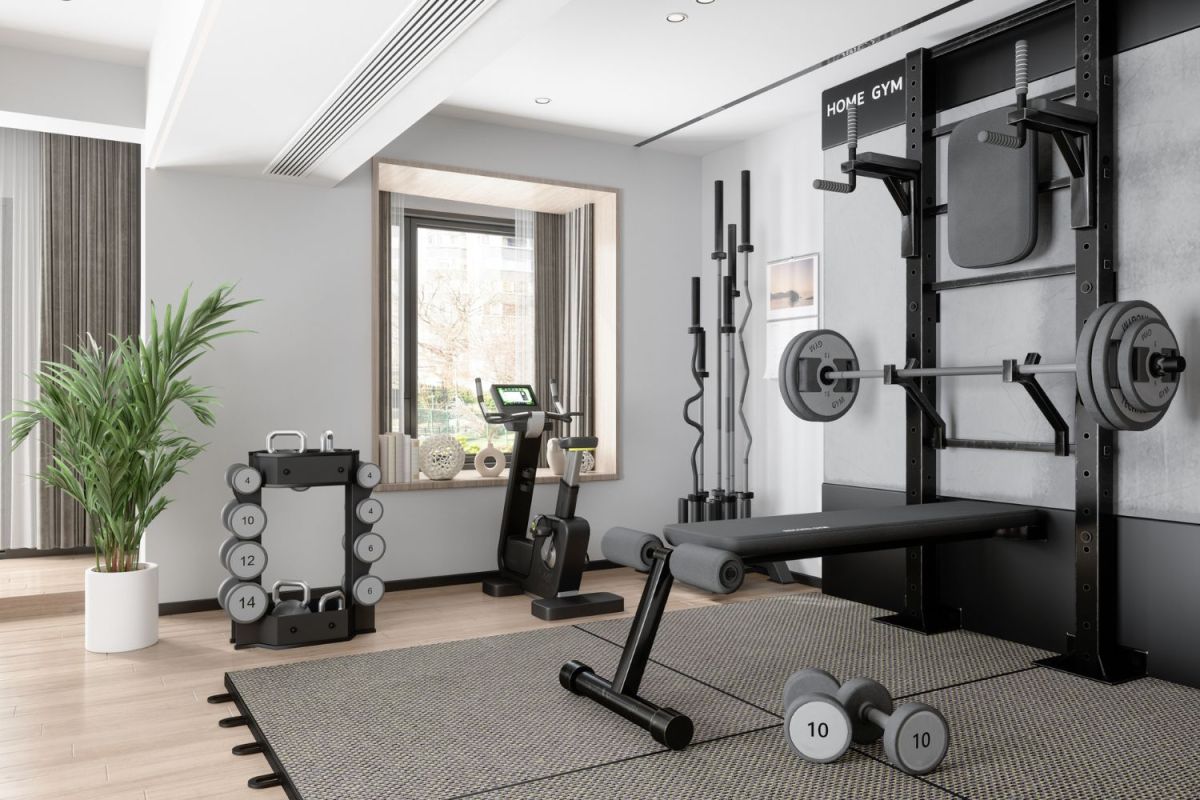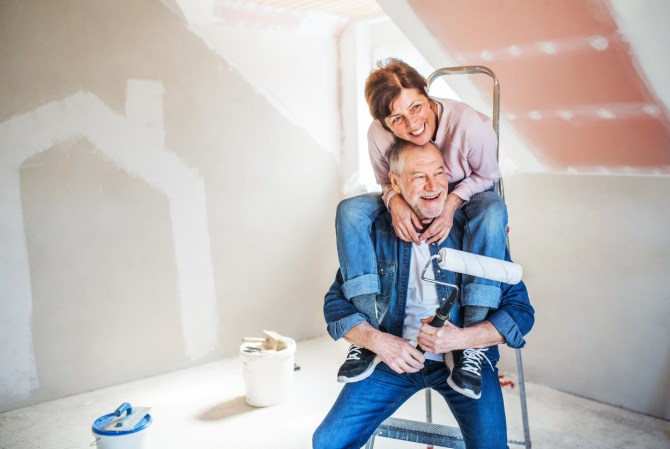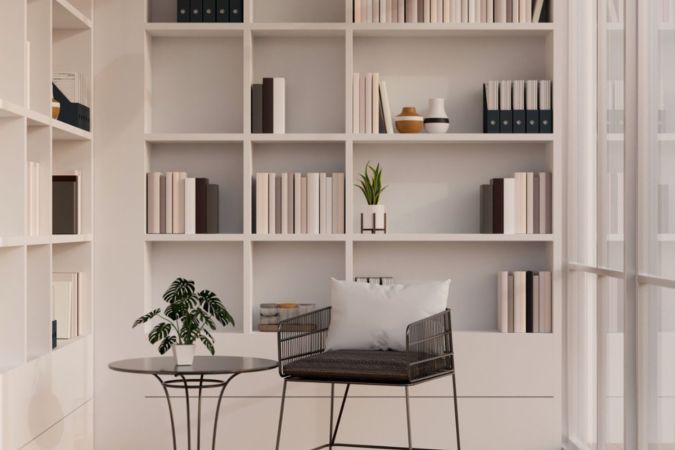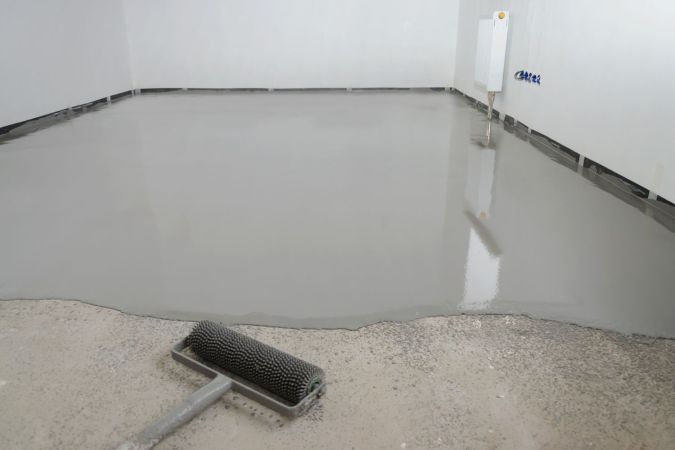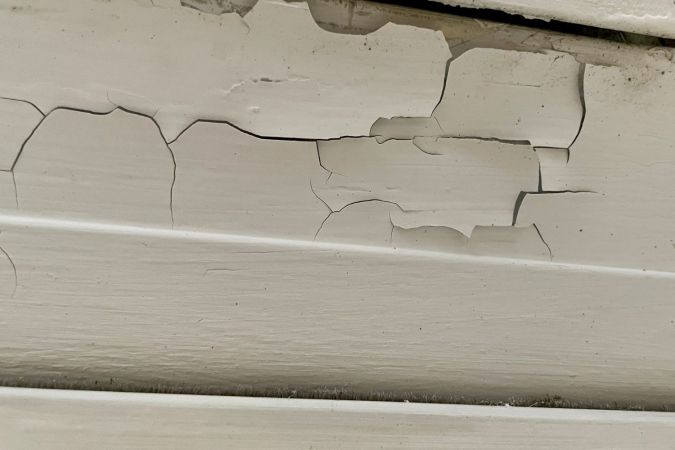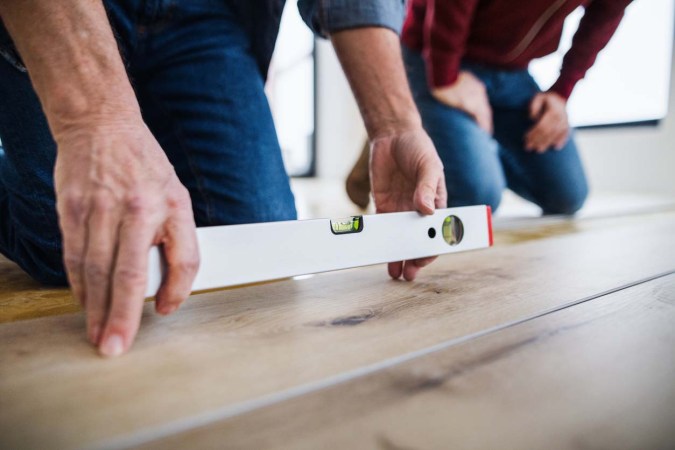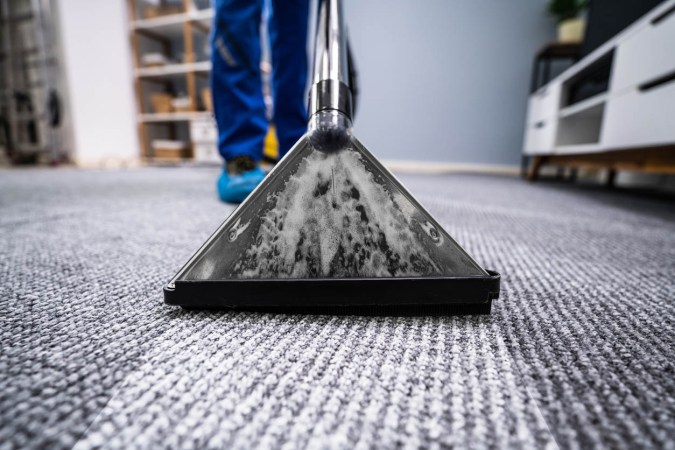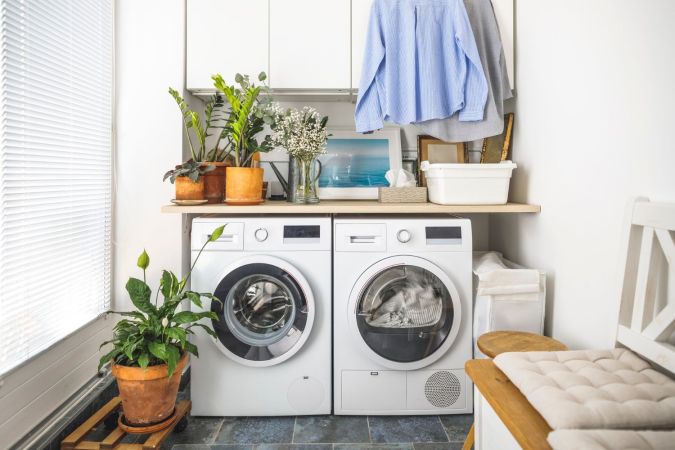We may earn revenue from the products available on this page and participate in affiliate programs. Learn More ›
Highlights
- A home gym has a typical price range of $300 to $15,000, with a national average cost of $2,000.
- The final cost is affected by factors such as the type of gym being built, the flooring material, and the type and brand of equipment.
- Some of the benefits of a home gym include time and cost efficiency, privacy, convenience, and flexibility.
- A homeowner may be able to build a basic home gym themselves, but they’ll likely want to hire a professional contractor for a more major gym project.
Most people who join gyms have the best intentions of going before work or during their lunch hour to lift weights or run a few miles on the treadmill. Unfortunately, things like schedules, the weather, traffic, and motivation can get in the way of these intentions, and as more and more people are able to work from home, the inclination to go to the gym falls by the wayside. Whether a homeowner has a busy schedule that makes it hard to get to the gym or prefers to work out in private, they may benefit from building a gym at home.
The home gym setup cost varies widely based on what the user is looking for. A gym can be built over time, with equipment and machines added as needed, or a whole space can be fully outfitted at once. For this reason, the home gym cost range is wide, with HomeAdvisor estimating a typical cost between $300 and $15,000 and a national average of $2,000. A few mats, a bench, and some dumbbells are enough to get started, but for those who are already regular gym users, purchasing gym-quality machines and creating a dedicated space within the home can swing the cost much higher. It’s important for a homeowner to carefully think through what they will need, want, and actually use before creating a design for a home gym. They may want to look at some home gym pictures online for inspiration; some of the coolest home gyms aren’t fancy but are really tailored to the exact needs of the users. There are quite a few components for homeowners to consider, from the equipment and air-quality control to the flooring, lighting, and safety precautions, so it’s ideal to understand and balance all of the options in order to create a realistic budget. An online home gym cost calculator can help homeowners break down their options.
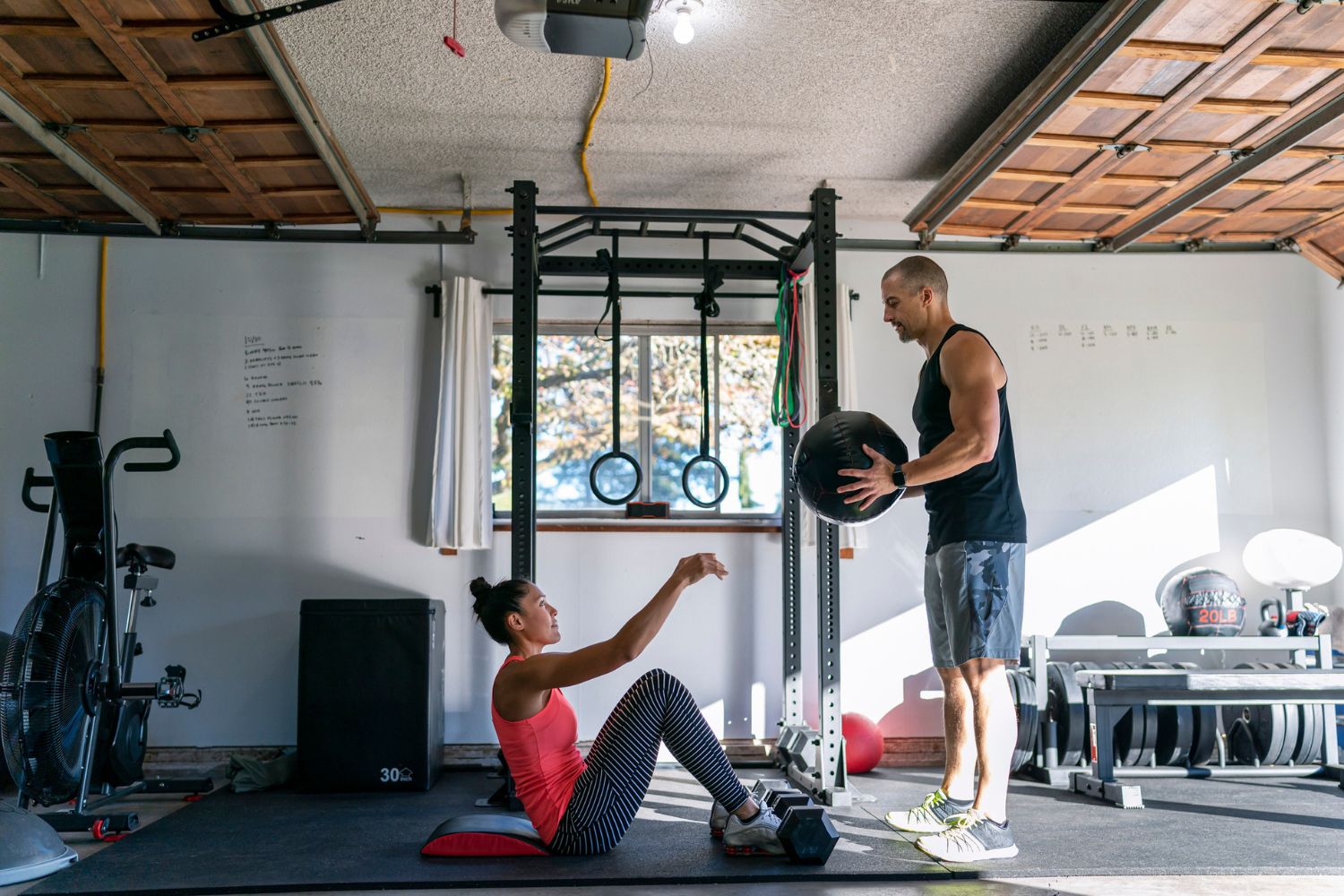
Factors in Calculating Home Gym Cost
Some factors will affect the budget more than others, and there are certain components that can’t be avoided when homeowners are crafting a home gym. These elements are necessary considerations that may require some research or expert opinions before a purchase is made; in order for committed exercisers to maximize the impact of the money spent on the gym, it’s important that they understand these elements so they can estimate how much a home gym costs.
Gym Type
The first and most important consideration is the type of gym that will meet the users’ needs. Are the primary users yoga enthusiasts? Cardio freaks? Bodybuilders? CrossFitters? These will affect the type of gym that needs to be built, and many of the other cost factors will be shaped around this decision. Before the user makes any other decisions, the purpose of the gym must be determined, as the equipment choices and outfitting will depend on the gym’s primary functions.
Gym Location
While some people think they can tuck a treadmill in the corner of the bedroom, a home gym needs its own dedicated space to be really effective, even if it’s a small space. A spare bedroom or basement is often the lower-cost option, as long as the bedroom floor is structurally able to support the machinery and equipment selected. A spare room gym can cost as little as $2,000 or as much as $10,000 if the floor needs to be bolstered, while a basement gym (where the floor strength is less of a concern) can range from $2,500 to $5,000. Garage gyms are similar in cost to basement gyms but can skew toward the higher end of the range if they need to be insulated. Attics fall into a similar range as well; their structures are built to support the roof, but they may require finishing, insulation, and floor reinforcement. Partitioning off a piece of a larger area can carve out a gym in a space that can also accommodate a living or storage area. The most expensive type of gym is a dedicated add-on space, where the homeowner decides to build an addition onto the home to accommodate the gym. A home extension cost can add between $20,000 and $100,000, so this is really an option only for customers who are certain the gym will get enough use to justify the cost.
For those who live in a climate where it’s warm enough to exercise outdoors all year (or those who love the outdoors in some seasons), there’s nothing that says a gym has to be indoors. A great outdoor home gym can be built in a backyard, on a patio, or on a deck. Patio gym ideas can include some bars and portable equipment such as weight benches, weight racks, squat bars, and a yoga mat with a few dumbbells. Many backyard gym ideas can be found online, and ninja-style training courses and obstacle courses are great outdoor gym ideas. If the budget allows, there are many types of cardio equipment available in outdoor versions that can stand up to light weather conditions, though they will need to be covered well or brought indoors in case of heavy rain or any snow. A carport or overhang above the gym makes installing an outdoor television simple for streaming video classes or workouts (or just a movie while cycling). An outside home gym can run between $5,000 for some equipment and weather protection to as much as $80,000 for tennis or basketball courts installed by workout buffs.
Equipment Type
Basic gym equipment cost, such as for yoga mats, lightweight kettlebells, and jump ropes, doesn’t have to break the bank. These pieces can be acquired relatively inexpensively at department stores or online. As the equipment gets heavier or more sophisticated, the prices rise to match. Heavier dumbbells, especially those that are textured or coated to prevent slippage, can cost as much as $400, as can heavy kettlebells. Plates for bench press weight bars or weight machines (just the plates, not the bars) can run between $45 and $300. Weight benches can cost as little as $100 or as much as $1,000 for a bench that features different angles and weight positions.
The following is a breakdown of some common types of equipment found in home gyms and their average cost ranges.
| Type of Equipment | Average Cost |
| Barbells | $50 to $800 each |
| Dumbbells | $25 to $400 each |
| Elliptical | $300 to $2,000 |
| Indoor Bike | $300 to $2,500 |
| Kettlebells | $25 to $400 each |
| Medicine Balls | $30 to $150 each |
| Plates | $45 to $300 each |
| Rowing Machine | $600 to $1,200 |
| Treadmill | $400 to $1,500 |
| Weight Bench | $100 to $1,000 |
Designers will find an even wider range of home gym prices once cardio equipment or weight systems that can support heavier weights enter the picture. Why the range? Most gym equipment is offered in several lines or ranges, sometimes by the same manufacturer. “Home quality” gym equipment is often available in the range of $300 to $600 for a basic elliptical, bike, treadmill, rowing machine, or squat rack. Equipment at this level is likely to be pretty bare-bones and may lack the connectivity options, features, and heft or stability that higher-grade equipment includes, because it’s intended specifically for home use by one or two people and doesn’t need to stand up to the rigors of dozens of users each day. For many home gym users, this level of equipment will be sufficient as long as it’s placed on a level surface and cared for appropriately. Some users may choose to spend more for features such as Wi-Fi connectivity, heart rate monitors, or screens that include additional health tracking. Often, the best treadmill options come with a built-in screen that allows the user to “run” virtually in locations around the world, which is an attractive feature and could mean the equipment gets more use.
Serious users may choose to purchase gym-quality equipment, sometimes labeled “commercial quality.” These machines are extremely stable, full-featured, and built to last, but they’ll cost more accordingly: Equipment that costs $300 to $600 for home use can rise to $1,000 to $2,500 for commercial grade.
Equipment Brand
As with any other product, some brands promise high quality with their reputations and are priced accordingly, while other brands (which may not be of lesser quality overall) cost less because their name is not as well known.
The following is the average cost of equipment from some of the best-known home gym brands:
| Brand | Average Cost for Equipment |
| Bowflex | $500 to $1,500 |
| Hoist Fitness | $1,700 to $4,900 |
| Impex | $300 to $1,500 |
| Iron Grip | $3,000 to $5,000 |
| NordicTrack | $2,000 to $3,000 |
| Peloton | $1,500 to $2,500 |
| Precor | $1,200 to $2,300 |
| Titan Fitness | $200 to $1,500 |
| Tonal | $3,000 to $3,500 |
| Total Gym | $700 to $3,800 |
| TuffStuff Fitness | $3,200 to $7,750 |
Some of the best home gym equipment brands boast name recognition and often include warranties and a high resale value. New types of gym equipment, such as workout mirrors—reflective displays that let a user see their posture and form as they work out with a virtual class that is streamed in—come out all the time. The cost of mirror home gyms such as those offered by Tonal can be high, but the unique opportunity for the user to feel like they are actually in a class with others sets this option apart from regular equipment. One of the benefits of selecting a single brand to purchase when outfitting a home gym is the cost factor; many brands offer all-in-one gym stations or package deals for customers who purchase several pieces of their equipment. These units and packages can provide reasonable cost savings, so it’s worth investigating what’s available from a single brand prior to selecting individual pieces of equipment across the brand spectrum.
Flooring Type
Flooring is a critical component of any home gym. First, the subfloor (the structural support beneath the tiles, hardwood, or carpeting) must be strong enough to support the equipment the gym will house—and remember, that equipment will have a person on it exerting strength, so it’s not just the weight of the equipment but the weight of the person and the force of the energy. If the subfloor needs repair or replacement, the work will cost an average of $430 or $2,980, respectively.
Once the subfloor is secure, the floor surface must be selected. Ideally, the flooring will offer some cushion and traction while remaining firm enough to offer a solid base (ankles, knees, and equipment are all more prone to rolling when the surface is too soft). In a garage or basement, the polished concrete that may already be in place may be sufficient, but most people will want a bit more cushion. The best gym flooring options will be both affordable and comfortable and also help prevent injury.
The following are some of the most common types of flooring homeowners choose for their home gyms.
- Rubber flooring: Rubber flooring is ideal and costs between $2 and $16 per square foot depending on the thickness and the style (tiles or roll-out).
- Foam tiles: Foam tiles are an inexpensive option—between $0.50 and $3 per square foot—and can be placed on top of other flooring, which means they can be removed more easily if the room needs to be repurposed.
- Vinyl flooring: Vinyl flooring—tile, plank, or sheet—can also be a good and versatile choice, especially for rooms with multiple functions; it costs between $2 and $14 per square foot.
- Carpet: Carpet is also an option but not an ideal one: It’s gentler on the knees than some choices, but it can be surprisingly slippery, and if the carpet has a high pile, it can make narrower equipment such as benches or spin bikes quite unstable. Carpet costs between $7 and $12 per square foot.
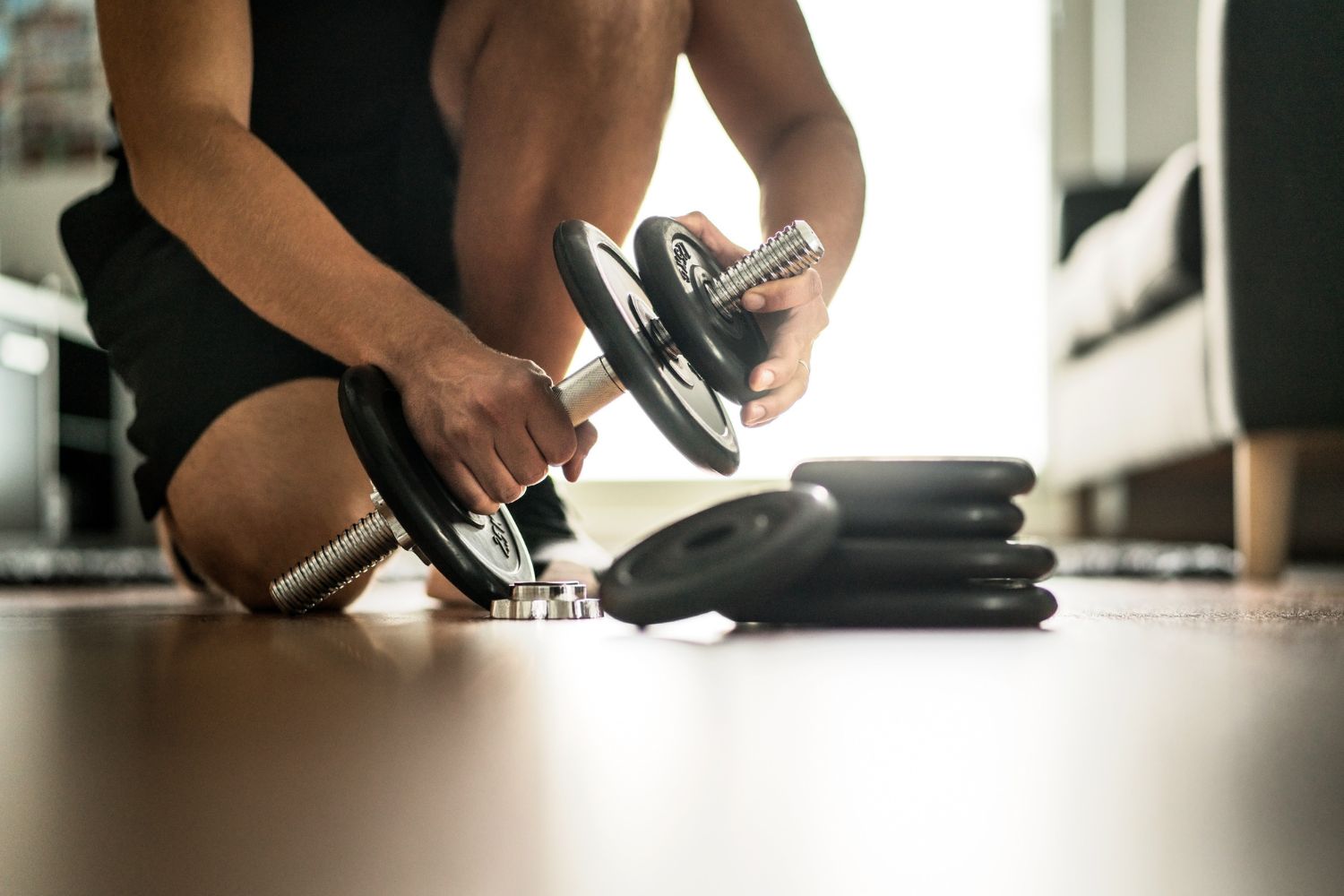
Additional Costs and Considerations
Once the basics are selected, there are some other factors to consider when exercisers are building a home gym. These aren’t incidental: They can make up a significant portion of the budget, and while some of them seem less critical than the actual gym equipment, they can make the difference between a spare room with some exercise equipment and a real home gym. If the decision has been made to invest in the space, it’s worth investing a bit more to finish the space properly.
Electrical and Lighting
It’s possible that the electrical supply to the area designated for the home gym is already sufficient, but when homeowners are installing several cardio machines into a space, it makes sense to have an assessment done by an electrician, especially if the home is older or more than one of the machines will be in use at one time. In addition, cardio equipment is usually supplied with shorter electrical cords for safety purposes, so additional outlets may be necessary. Running wiring to new outlets can cost between $3 and $5 per foot, but if the home’s energy supply isn’t adequate to cover the equipment, it may be necessary to upgrade the service and the electrical panel, which can cost between $550 and $2,300.
With the wiring for the equipment in place, it’s likely that the space will require additional lighting, both to make the space pleasant and to create a safe space to work out. Ideally the space will have windows that provide natural light, but in the early morning or late at night (or if a windowed space isn’t available), some fixtures that simulate sunlight will be best. It may be preferable to recess the lights so they’re out of the way and don’t create a hazard. Installing light fixtures will cost between $150 and $920 depending on the style of fixture and the difficulty of installation.
Subflooring Repair or Replacement
If the subfloor needs to be repaired or replaced to support the weight of the gym equipment or to be releveled, the cost will be between $430 and $2,380, respectively. This job can be as simple as adding leveling compound or replacing old plywood subfloor with newer, stronger material or as complex as shoring up the joists beneath the subfloor to add strength. It’s usually a job for a professional, unless the homeowner is well versed specifically in subfloor construction.
Mirror Installation
Most professional gyms have a wall of mirrors. This isn’t just so the people exercising can admire themselves—mirrors in gyms are actually important tools that allow those using the equipment or stretching to check their form and prevent injury. Mirrors also have the benefit of making a small space seem larger. Because wall mirrors in gym spaces tend to be somewhat large, they require special handling and installation, which will cost between $160 and $460.
TV Installation
Watching a workout video? Streaming a video from someone’s GoPro so it feels like a trail run instead of a treadmill workout? Desperately in need of the latest episode of a favorite show or movie to keep the motivation going through the end of an elliptical session? A television in a home gym provides instruction and distraction, but if it’s precariously perched on a table or box, it can be dangerous. Mounting the television can cost between $160 and $360, not including the cost of the unit itself.
HVAC Installation
Nobody wants the dank scent of gym socks and towels lingering in their home. Because a space that can become damp over time may develop mold or mildew, air-quality management is important. Ceiling fans can add excellent air circulation in many spaces and can be installed for $140 to $350. In rooms that are already damp or in particularly small spaces, a dehumidifier might be an important consideration. A whole-house dehumidifier can cost between $1,300 and $2,800, while portable units can cost significantly less. If the space doesn’t have existing heating or cooling units (such as an unfinished attic or basement, or possibly a garage), it may be necessary to install a complete HVAC unit, which may cost between $5,000 and $10,000.
Equipment Assembly
Depending on where the equipment for the gym is purchased, the price may include assembly and installation. If it does not, there may be an option to add that cost to the delivery, or it may be necessary to hire an installer or handyman to assist with the assembly and installation, as quality gym equipment is fairly heavy and assembly is rarely a one-person job. Assembly and installation can cost between $85 and $95 per item.
Customizations
People who choose to build home gyms often have a picture in their heads of what their ideal gym space will include. This may involve built-in racks for weights, custom storage for accessories, surround-sound speakers for an immersive experience without headphones, or even a sauna. Those with limited mobility may need extra customizations so that they can access the equipment more easily or safely. The benefit of building a gym is that the user can specify these needs and have them met, but the cost of home gym customization will vary based on the user’s requirements.
Types of Home Gyms
The total home gym price will depend largely on how the homeowner plans to use the space; some people simply want a clean, beautiful area where they can do a little yoga and stretching, while others may be mapping out an extensive and elaborate training program that requires lots of equipment. The type of gym will determine many other elements, such as the type of equipment and the required space.
Yoga Gym
Yoga gyms are fairly straightforward. A quality yoga mat, a yoga strap and blocks, and likely a mirror to check form and possibly some music and a fan are really all that’s necessary. Because there’s no heavy equipment, remodeling is rarely necessary, but new flooring could be a consideration, as the user will spend a fair amount of time on the ground. A yoga gym will range between $15 and $180.
Pilates Gym
While a Pilates gym can be similar in cost to a yoga gym, it can also swing much higher on the cost scale. Basic Pilates equipment includes mats, stability balls, and weights, along with a suspension bar and straps. Those basics can cost as little as $100. However, Pilates reformers are necessary for advanced Pilates practice. These higher-end devices can cost up to $2,000.
Weight Lifting Gym
If the primary goal of the gym is weight training, the cost of equipment will have a pretty wide range. Basic mats and dumbbells aren’t a huge investment, but a gym focused on weight lifting will also require a weight bench, barbell and plates, a wider range of dumbbells and kettlebells, and possibly a squat rack. In addition, all-in-one or weight stack machines that permit multiple options for strengthening different weight groups can be costly. The cost to outfit a weight gym will range between $580 and $5,050.
Calisthenics Gym
Calisthenics use body weight to build strength and flexibility, so it would seem that the cost to build a home gym focused on this type of exercise would be low. And in general it is, as the user’s body provides most of the weight needed. However, items such as pull-up bars or handles, dip bars, resistance bands, rings, and an ab mat or wheel can range from $200 to $1,000 to fully stock a calisthenics-focused home gym. This type of gym also requires softer flooring or mats to cushion the user for floor work.
CrossFit or Functional Training Gym
As CrossFit has become more and more popular, many home exercisers have sought to build their own versions of CrossFit at home. The equipment needed for functional training isn’t unusual, but to get the full range of motion that functional training requires, a fair amount of equipment is needed, such as bars, weights, weighted vests, plyo (plyometric) boxes for jumping, ropes, and pull-up bars, in addition to battle ropes and mats, can drive the cost up to between $1,500 and $4,000.
Cardio Gym
Home gyms focused on cardio can be quite inexpensive, if the selected equipment is limited to non-electronics: speed ropes, battle ropes, and boxing equipment ranges from $10 to $50 on the lower end. The best rowing machines, treadmills, ellipticals, and spin bikes range from $100 to $200 on the lower end to $8,000 for high-end commercial-grade pieces.
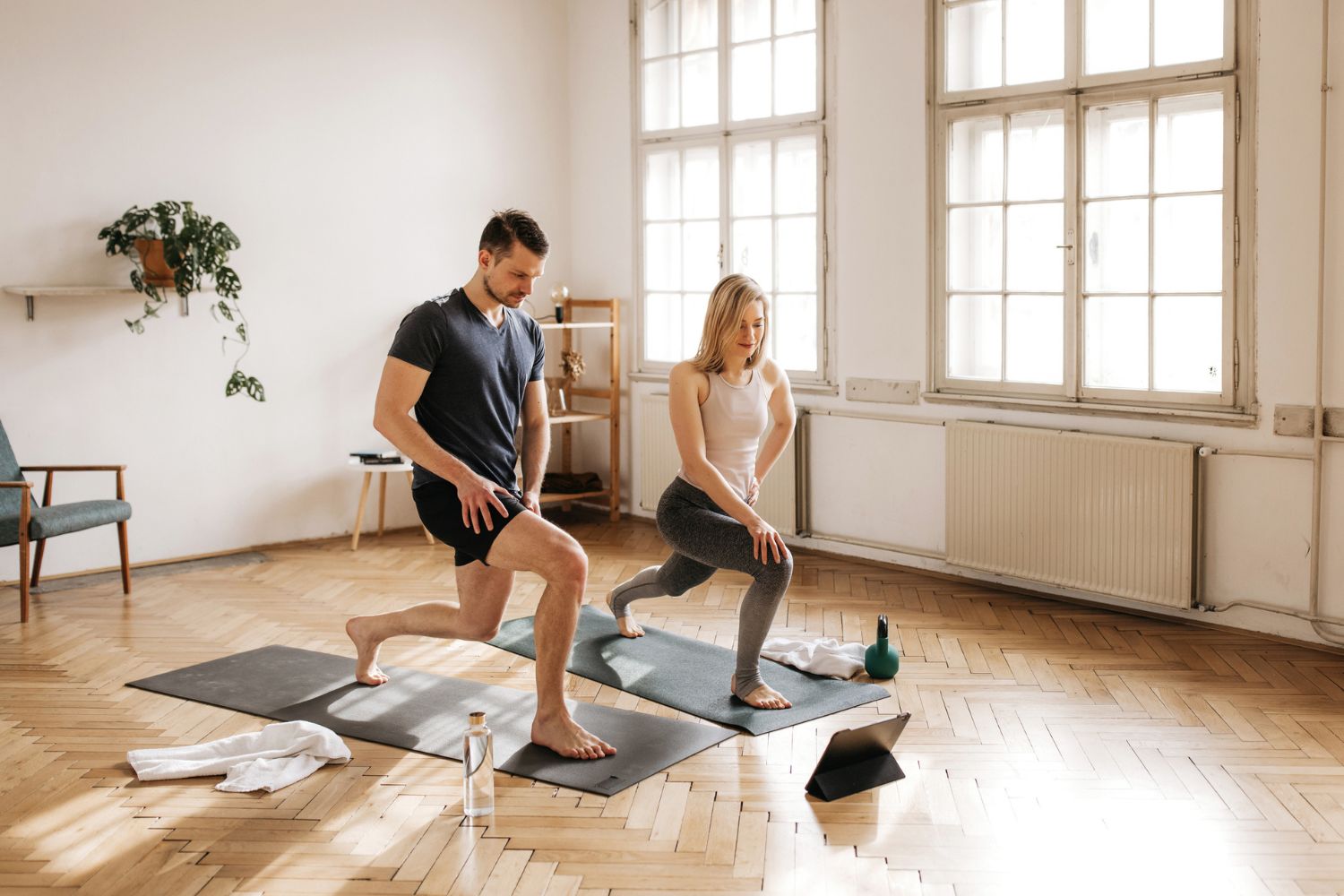
Benefits of a Home Gym
With membership-based professional gyms sprinkled across the country, why spend the time and money to build a gym at home? There are financial and time considerations but also personal choices. Some people need the pressure of having paid for a membership to make them build the habit of going out to the gym, and some simply prefer the escape to the gym to focus on their wellness. But other people can’t motivate themselves to leave the house, or don’t think they have time, so having the gym right down the hall is the only way they can commit to their health.
Time Efficiency
How long does it take to go to the gym? Pack up a bag, fill the water bottle, and drive or walk to the gym (is it close to home, or is the “good gym” or the “affordable gym” farther away?). Check in, find a locker, change. Actually work out. Shower, change, drive home, start laundry, wash the water bottle. That’s a lot of time and effort. With an in-home gym, users can wear their gym clothes to bed and leave a full water bottle at the ready, get up, work out, then shower and go about their day, or pop in to do a quick run at lunch or after dinner. There’s no fuss, and the workout can seamlessly become part of the day without eating up a lot of extra prep and travel time.
Cost Efficiency
Building a home gym does require an initial investment in equipment that the user purposely selects because they know they will use it. Gym membership is a subscription-based continuous cost that may cover access to a lot of equipment the customer never uses. Unless there’s equipment that the user needs that would be completely cost-prohibitive to install at home, such as a lap pool, the home gym setup cost will, over time, be a less-expensive option than the cost of gym membership. Should the user tire of a particular piece of equipment, they can sell it and purchase something different, having offset the cost with the sale of the older piece.
Convenience
Simply put, it requires less motivation, time, and energy to walk down to the basement than it does to travel somewhere else. Having the gym in the house is more convenient than finding a commercial space for a workout and getting there.
Privacy
Some people thrive on working out among others who are similarly motivated. Others squirm at the prospect of anyone else seeing them exercise, either because they’re self-conscious or because they’re not confident that they know how to use the equipment. A home gym allows exercisers to experiment with new techniques and equipment without observation by others, and as a result it may let those who prefer privacy work out more effectively.
Freedom and Flexibility
Anyone who has ever watched precious minutes tick by while waiting for the piece of equipment they need understands the beauty of having that one piece of equipment in their home with no lines or competition. The equipment in a home gym is specifically selected for the people who will be using it, so there’s nothing unnecessary cluttering up the space, it’s exactly what the users need, and it’s always available.
Not everyone wants or needs to exercise for a solid block of time each day. Especially for those who are beginners or are recovering from an injury, or those who have a busy and inflexible schedule, it can be much more beneficial to pop into a home gym for several shorter sessions throughout the day, with stops to rest or work in between. That’s not possible at a gym without a lot of unnecessary driving and expense.
Home Gym Installation: DIY vs. Hiring a Professional
Can a home gym installation be a DIY project? It depends. A simple gym with a mat and basic equipment is absolutely a DIY project. As soon as the project becomes more complex, however, it’s a good idea for homeowners to consider hiring some help. Gym equipment is heavy and unwieldy, so even carrying it to its designated location alone or as a twosome can be risky. Assembly is difficult without extra pairs of hands—nobody wants to injure themselves while assembling home gym equipment and then be unable to use it. The best home renovation contractors have experience moving heavy items and repurposing rooms and will be able to create the ideal gym space. Homeowners can search for “contractor near me” to find a local professional who will be able to help with their home gym installation.
Any home gym project that requires adding or moving outlets, installing lighting that requires wiring, hanging a large mirror, or installing HVAC may require a local permit. It’s best for homeowners to seek an electrician to help secure the permit and get the job done correctly. And if there’s any concern at all that the floor may need to be bolstered to support heavy equipment, homeowners will want to hire someone to assess the floor strength and follow their recommendations. Otherwise, the ensuing disaster from a DIY gym can be expensive to repair and can cause significant injury.
How to Save Money on Home Gym Cost
Outfitting a gym can be an expensive proposition, but there are many ways to save on equipment costs if the shopping is done carefully.
- Research. Read up on different types of equipment before purchasing to understand how much the desired equipment should cost and to make sure that what’s advertised as a bargain really is a bargain.
- Watch out for sales. Shop at the end of the year, when exercise equipment often goes on sale.
- Shop carefully for used equipment. Some stores specialize in selling used commercial equipment, and customers can score excellent deals on high-end equipment in great shape that a professional gym has retired as part of a planned replacement schedule.
- Ask a friend. Let people know that you’re looking for equipment. A friend or coworker may have good-quality equipment that they aren’t using and will happily take less than market price to get it out of their home.
- Look for package deals. Consider brand-specific package deals or all-in-one units that can provide a lot of bang for the buck.
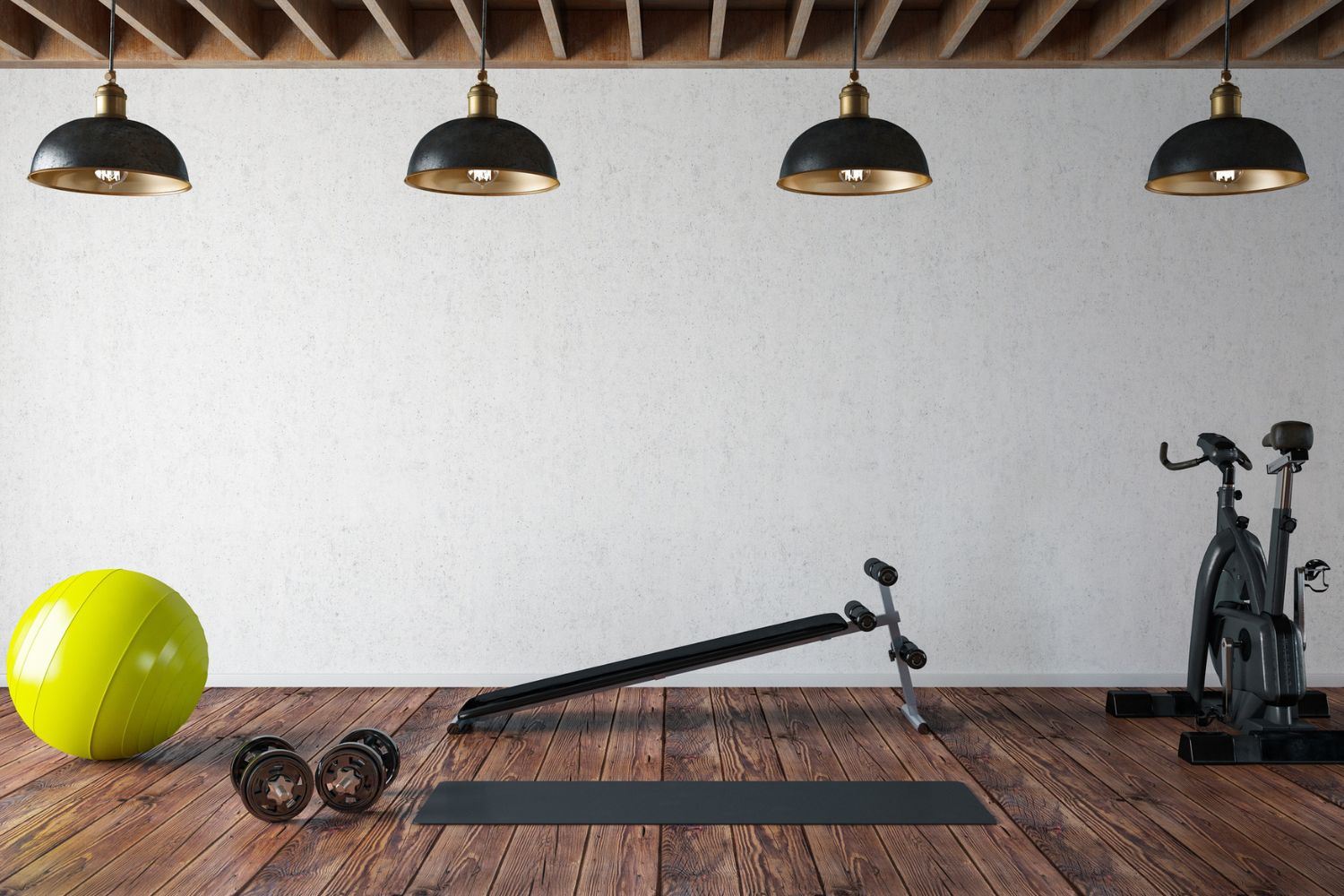
Questions to Ask About Home Gym Installation
For customers unfamiliar with the terminology of gym equipment or who aren’t sure what they want, it’s a great idea to use the expertise of the salespeople at local gym equipment stores—but it’s also important to know what to ask.
- What equipment will fit into the space designated for my gym?
- How much space does this piece of equipment need around it during use?
- Will this piece of equipment fit through the doorways and hallways between my driveway and the gym?
- How should I maintain and service my home gym equipment? Does the manufacturer or retail establishment offer warranties or service contracts?
- Are the installers licensed and insured, and are they covered by workers’ compensation?
- Gym equipment is heavy. How will the installers protect my home from damage? Who is responsible if my home is damaged by an installer or a piece of equipment?
FAQs
There are many decisions to be made when homeowners are building a home gym, and it can be a bit overwhelming. These are some of the questions we’re often asked about this type of project and the answers to get you started on your project and budget planning.
Q. Where should I set my gym at home?
This depends on what kind of exercise you plan to do in the gym space. Yoga can be set up in the corner of a spare bedroom, while large cardio and weight training equipment needs to be placed somewhere with appropriate floor space and strength. Regardless of what type of exercise will be done, ample room and ventilation—and ideally some fresh air and sunshine—will make the space more inviting and healthier to use.
Q. What should I avoid having in my home gym?
One mistake home gym builders frequently make is trying to replicate a commercial gym in their home. A home gym doesn’t need every possible piece of gym equipment—it needs the gym equipment the owner will regularly use. Also, many people choose to install new or leave existing carpeting in a home gym space. While it’s not absolutely prohibitive, carpeting is a less stable foundation for equipment than other types of flooring and can harbor mold or mildew, so it’s not the best choice. If it’s not feasible to replace existing carpet, consider adding something firmer over the top before placing heavy equipment on it.
Q. Can I convert my garage to a home gym?
Indeed, you can! The solid concrete flooring and high ceiling in most garages make it an ideal space to use for a gym, with a couple of caveats. First, it’s important to really clear the space: This is no time to think “Well, that pruner is pretty well tucked back on that shelf.” Exercise requires freedom and security of movement. Trip hazards and tools that will be dangerous if someone falls into them need to be completely removed. Second, consider the local weather and assess the garage space. Will it be cool enough in summer? Warm enough in winter? If the answer isn’t an absolute yes, then allocate some of the budget to insulation as well as heating or cooling units. Garage gym costs can be less than the cost of home gyms in other spaces, because there’s rarely a need to redo the subfloor, and the space is easier to retrofit.
Q. What is the average cost of building a home gym with a variety of equipment?
The average cost is about $2,000, but that cost can range from $300 to $15,000 depending on the selection of equipment and the requirements of the space. There are many ways to save money on equipment and supplies, and it’s easy to accidentally overbuy, so exercise priorities and judgment when making selections.
Q. How much space do I need for my home gym?
That depends on what you’re planning to put into it. A basic treadmill and some hand weights won’t take up much space, and a small but adequate gym can be housed in as little as 100 square feet. The more equipment you want, the more space you’ll need.
Q. Do I need airflow in my gym, and how can I ensure I have it?
Good airflow in a gym is key for preventing overheating and encouraging oxygenation, and it also prevents mold and mildew from taking root. Opening a window keeps the air fresh and clean, but so can using a portable air-conditioning unit, a ceiling fan, or even a high-powered box fan. Keeping the air circulating freely and forcefully is an important component of building a home gym.
Sources: HomeAdvisor, Fixr

